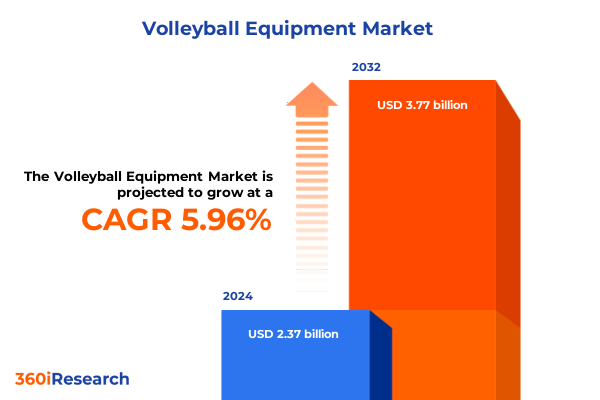The Volleyball Equipment Market size was estimated at USD 2.37 billion in 2024 and expected to reach USD 2.50 billion in 2025, at a CAGR of 5.96% to reach USD 3.77 billion by 2032.

Unveiling the Evolving World of Volleyball Gear Where Innovation, Performance and Consumer Demand Converge to Shape the Future of Equipment Technology
The global volleyball equipment industry is experiencing a period of unprecedented transformation as technological innovation, evolving consumer preferences, and rising participation converge to reshape the market landscape. With over 800 million passionate fans worldwide and 222 national federations under the International Volleyball Federation’s (FIVB) umbrella, volleyball has transcended its traditional boundaries, capturing both grassroots and professional athletes’ imaginations. Emerging markets in Asia, Latin America and Eastern Europe are driving participation rates higher, while established leagues in North America and Western Europe continue to invest in infrastructure and talent development to sustain competitive excellence.
How Technological Breakthroughs and Sustainability Movements Are Revolutionizing Volleyball Equipment Design Distribution and Player Experience
Seminal advances in digital integration and sustainability are redefining the essence of volleyball equipment, marking a new era of performance-driven designs and environmentally conscious practices. A host of smart volleyballs embedded with motion sensors now capture serve velocity, spin rates and impact forces, delivering real-time analytics that coaches and athletes leverage to refine technique on the fly. Furthermore, virtual reality platforms simulate competitive match scenarios, enabling players to sharpen decision-making and spatial awareness without stepping onto a physical court.
Assessing the Ripple Effects of 2025 U.S. Tariff Measures on the Volleyball Equipment Supply Chain, Manufacturing Costs and Market Dynamics
In 2025, U.S. trade policy introduced substantial tariffs aimed at reshaping domestic manufacturing and trade balances, leading to direct repercussions across the volleyball equipment supply chain. Effective March 4, 2025, an additional 25% tariff was imposed on goods from Canada and Mexico, and a 20% surcharge applied to imports originating from China. Moreover, from March 12, 2025, a universal 25% tariff targeted steel and aluminum imports to bolster U.S. metal industries, further increasing production costs for volleyball posts, net frames and related hardware.
Deep Insights into Volleyball Equipment Segmentation Revealing Distinct Opportunities Across Product Types End Users Materials and Distribution Channels
A nuanced understanding of market segmentation reveals the intricate dynamics governing volleyball equipment demand across diverse categories and user profiles. Differentiating products by type-from accessories and apparel to balls, core equipment and specialized footwear-enables stakeholders to tailor development and marketing strategies to specific performance requirements and consumer preferences. The market’s division between indoor and outdoor volleyball dictates material composition and structural design, as indoor disciplines demand precision-engineered synthetic or composite surfaces, while outdoor variants emphasize durability against sand and UV exposure. Material segmentation underscores the importance of composite blends in delivering optimal balance between resilience and weight, complemented by leather options prized for traditional feel and synthetic variants catering to cost-conscious segments.
This comprehensive research report categorizes the Volleyball Equipment market into clearly defined segments, providing a detailed analysis of emerging trends and precise revenue forecasts to support strategic decision-making.
- Product Type
- Type
- Material
- End User
- Distribution Channel
Regional Dynamics in Volleyball Equipment Markets Highlighting Growth Drivers Competitive Landscapes and Unique Opportunities Across the Americas Europe Middle East Africa and Asia Pacific
Geographical analysis highlights distinct growth trajectories and regulatory environments that shape regional competitive landscapes. In the Americas, the United States leads with robust collegiate and youth league engagement, supported by investments in facility expansions and broadcast partnerships. Meanwhile, Latin American countries are witnessing surging popularity in beach volleyball, driven by iconic coastal venues and Olympic success stories. Across Europe, the Middle East and Africa, longstanding professional circuits in Italy and Poland coexist with emerging markets in the Gulf region, where sports tourism initiatives and government-backed sports federations are catalyzing demand for high-quality equipment. Asia-Pacific stands out as the fastest-growing region, underpinned by increasing disposable incomes, expanding grassroots programs in China and India, and strategic collaborations between local manufacturers and global brands to meet nuanced consumer requirements.
This comprehensive research report examines key regions that drive the evolution of the Volleyball Equipment market, offering deep insights into regional trends, growth factors, and industry developments that are influencing market performance.
- Americas
- Europe, Middle East & Africa
- Asia-Pacific
Strategic Profiles of Leading Volleyball Equipment Manufacturers Showcasing Their Innovation Initiatives Partnerships and Market Positioning Strategies
The competitive arena of volleyball equipment is dominated by manufacturers leveraging heritage, innovation and global distribution networks to consolidate market share. Molten, recognized for its official FIVB-approved balls and advanced ball-bladder technology, continues to expand its smart ball offerings, incorporating sensor data analytics to enhance training methodologies. Mikasa, a pioneer in beach volleyball ball design, maintains its leadership through strategic partnerships with major international leagues and by integrating sustainability initiatives into its production processes. Wilson and Spalding, drawing on extensive insights from adjacent sports segments, have diversified their volleyball portfolios to include performance-oriented footwear and adaptive apparel, merging biomechanical research with athlete feedback. Meanwhile, footwear giants such as Nike and Adidas are accelerating their entry into volleyball-specific lines, applying proprietary cushioning systems and traction designs to meet the unique lateral movement demands of the sport.
This comprehensive research report delivers an in-depth overview of the principal market players in the Volleyball Equipment market, evaluating their market share, strategic initiatives, and competitive positioning to illuminate the factors shaping the competitive landscape.
- AALCO Manufacturing
- Adidas AG
- Amer Sports Oy
- ASICS America Corporation
- Baden Sports
- Bison, Inc.
- Bodyprox
- Carroll Seating Company
- Carron Net Company, Inc
- Carter Crompton
- Cobra Volleyball
- Douglas Sports
- Gared Holdings LLC
- Garmy Sports
- Gourock Inc
- Jaypro Sports, LLC
- Mikasa Corporation
- Mizuno Corporation
- Molten Corporation
- Nike, Inc.
- Schelde Sports
- SNA Sports Group
- Spalding Sports Equipment
- Under Armour, Inc.
- United Volleyball Supply, LLC
- VolleyCountry
Actionable Strategies for Industry Leaders to Navigate Market Disruptions Seize Emerging Trends and Drive Sustainable Growth in Volleyball Equipment
Industry leaders are encouraged to adopt a multifaceted approach to navigate evolving market conditions and capitalize on emerging trends. Prioritizing supplier diversification and nearshoring strategies can mitigate the impact of tariffs and supply chain disruptions, ensuring continuity of critical components such as high-grade composite materials and metal frameworks. Investing in product differentiation through integrated sensor technologies and modular design elements will position brands at the forefront of performance innovation. Simultaneously, embracing sustainable materials and circular manufacturing practices can resonate with environmentally conscious consumers and preempt regulatory shifts targeting single-use plastics and nonrenewable inputs. Strengthening omnichannel distribution, with seamless digital-to-physical experiences and direct-to-consumer platforms, will enhance brand loyalty while unlocking data-driven personalization opportunities. Finally, fostering partnerships with federations, professional leagues and grassroots programs can amplify visibility, facilitate product trials and reinforce brand credibility across diverse end users.
Comprehensive Research Methodology Employed to Deliver Rigorous Data Analysis Expert Insights and Holistic Understanding of Volleyball Equipment Trends
This research integrates both primary and secondary methodologies to ensure a rigorous, data-driven foundation for insights. Primary data collection encompassed in-depth interviews with equipment manufacturers, federation officials and professional coaches across key regions, complemented by surveys targeting amateur, recreational and professional players to capture end-user preferences. Secondary sources included comprehensive analysis of trade publications, regulatory filings and industry consortia reports. All data points underwent triangulation through cross-validation with customs import databases and financial statements from publicly traded firms. Segment definitions were meticulously refined by product type, play environment, material composition, user category and distribution channel to deliver granular insights. Regional breakdowns aligned with established economic zones and sports governance jurisdictions, ensuring consistency with international standards.
This section provides a structured overview of the report, outlining key chapters and topics covered for easy reference in our Volleyball Equipment market comprehensive research report.
- Preface
- Research Methodology
- Executive Summary
- Market Overview
- Market Insights
- Cumulative Impact of United States Tariffs 2025
- Cumulative Impact of Artificial Intelligence 2025
- Volleyball Equipment Market, by Product Type
- Volleyball Equipment Market, by Type
- Volleyball Equipment Market, by Material
- Volleyball Equipment Market, by End User
- Volleyball Equipment Market, by Distribution Channel
- Volleyball Equipment Market, by Region
- Volleyball Equipment Market, by Group
- Volleyball Equipment Market, by Country
- Competitive Landscape
- List of Figures [Total: 30]
- List of Tables [Total: 435 ]
Synthesizing Key Trends and Insights Underscoring the Imperative for Agility Innovation and Collaboration in the Volleyball Equipment Industry
The convergence of technological innovation, shifting trade policies and evolving consumer demographics is reshaping the landscape of volleyball equipment. Stakeholders must remain agile, harnessing data-driven insights to anticipate market shifts and respond to regulatory developments. Embracing digital integration and sustainability not only addresses current consumer expectations but also future-proofs product portfolios against environmental and compliance mandates. Strategic alignment with regional growth trajectories will unlock new revenue streams, while partnerships across value chains will foster collaborative innovation. Ultimately, the capacity to synthesize segmentation insights with competitive intelligence and actionable recommendations will distinguish market leaders from followers in a rapidly transforming industry.
Engage with Ketan Rohom to Secure In-Depth Volleyball Equipment Market Insights and Unlock Competitive Advantage Through Customized Research Solutions
Are you ready to elevate your strategic decision-making with comprehensive insights and tailored analysis on the volleyball equipment market? Reach out to Ketan Rohom, Associate Director, Sales & Marketing, to explore how our detailed research can provide you with the competitive edge you need. With personalized consultation and data-driven recommendations, we ensure you stay ahead of market trends, regulatory shifts, and emerging opportunities. Contact Ketan today to secure your copy of the full market research report and unlock actionable intelligence designed specifically for your organization’s growth and success.

- How big is the Volleyball Equipment Market?
- What is the Volleyball Equipment Market growth?
- When do I get the report?
- In what format does this report get delivered to me?
- How long has 360iResearch been around?
- What if I have a question about your reports?
- Can I share this report with my team?
- Can I use your research in my presentation?




